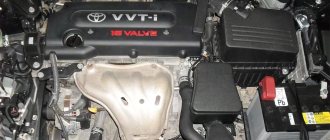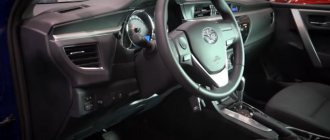Specifications Reviews
Toyota Avensis T22 is the first generation of a Japanese simple civilian car, released in 1997 to replace the Carina E. The manufacturer produced the car in three bodies: a sedan, a 5-door hatchback and a station wagon. The Japanese was successfully produced until 2003, undergoing restyling once in 2000.
Body
Toyota's design has always been simple, as they made relatively budget cars for the people. More than 20 years later, the body's survivability, not its appearance, should be discussed. There are many problems after so many years. Rust gradually affects all sides of the body, the bottoms of the doors and front fenders are the first to suffer, and the sills rot badly.
The pre-styling of the first Avensis had ordinary metal, so the windshield frame rusted, which promises difficulties during replacement. In the restyling, the roof was galvanized, freeing it from rot. Decorative moldings around the car often fall off or break.
Dimensions and types of bodies speak about other dimensions and their own problems. A station wagon, for example, loses its cover when the roof rails are removed.
Car sizes
Sedan:
- length – 4490 mm;
- width – 1710 mm;
- height – 1425 mm;
- wheelbase – 2630 mm;
- ground clearance - 140 mm.
The hatchback essentially differs in the shape of the trunk lid, the dimensions are the same, so it is more logical to classify it as a liftback.
Station wagon:
- length – 4570 mm;
- width – 1710 mm;
- height – 1500 mm;
- wheelbase – 2630 mm;
- ground clearance - 140 mm.
The wheel size is always identical - 185/65/R14.
Salon
Everything inside is simple - cheap cladding materials and minimal functionality, but reliable. The seats are covered with fabric, leather rarely appears. There is not enough free space inside, as evidenced by the size of the body.
Rear passengers have access to a folding armrest with a niche for small items and two cup holders. The sofa folds down to increase the trunk space. In general, trunk volume also depends on the body type:
- sedan – 500 liters;
- hatchback – 510 liters;
- station wagon - 530/1600 liters.
In the hands of the driver of the Avensis T220 is a simple 4-spoke steering wheel, behind which is a fully analogue instrument panel with fuel level, tachometer, speedometer and engine temperature sensors. The restyling introduced monitors that display various information.
The center console and air intake areas are surrounded by wooden inserts. In addition to emergency driving keys, the top is equipped with a heater and air conditioning unit on knobs and a ventilation shut-off toggle switch. Below is the standard cassette player. In the restyling, the climate control unit and radio were swapped, installing another disk radio. At the very bottom there is a cigarette lighter and an ashtray.
The Toyota Avensis T22 tunnel is minimally equipped - a handbrake, gear selector, cup molds and a hard armrest. Malfunctions include all sorts of little things - corrosion of the rear window lift cable, abrasions of plastic, fabric, etc.
Specifications
| Type | Volume | Power | Torque | Overclocking | Maximum speed | Number of cylinders |
| Petrol | 1.6 l | 101 hp | 136 H*m | 12.1 sec. | 190 km/h | 4 |
| Petrol | 1.6 l | 110 hp | 136 H*m | 11.7 sec. | 195 km/h | 4 |
| Petrol | 1.8 l | 110 hp | 155 H*m | 11 sec. | 195 km/h | 4 |
| Petrol | 1.8 l | 129 hp | 170 H*m | 10 sec. | 200 km/h | 4 |
| Petrol | 2.0 l | 128 hp | 178 H*m | 9.3 sec. | 205 km/h | 4 |
| Petrol | 2.0 l | 150 hp | 200 H*m | 9.1 sec. | 210 km/h | 4 |
| Diesel | 2.0 l | 90 hp | 203 H*m | 12 sec. | 180 km/h | 4 |
| Diesel | 2.0 l | 110 hp | 250 H*m | 11.4 sec. | 195 km/h | 4 |
Read more
The range of motors is extensive; these are old popular Japanese engines of excellent reliability. In the restyling, the engine was equipped with VVT-i variable valve timing systems, which increased power.
List of internal combustion engines:
- 4AFE – 1.6-liter 16-valve engine with a capacity of 110 horsepower and 145 units of torque;
- 7AFE – 1.8-liter engine also with 110 horses and already 155 H*m of torque;
- 3SFE – 2-liter engine producing 128 horsepower and 178 units of torque;
- 3ZZFE - the same 1.6-liter engine with the same power ratings;
- 1ZZFE – 1.8-liter engine with VVT-i, producing 129 hp. with 170 units of torque;
- 1AZFSE - a 2-liter engine, for which the VVT-i system increased power to 150 horses and 200 H*m of torque;
- 1CD FTV - diesel turbocharged 2-liter internal combustion engine of Avensis, with a capacity of 90 horses and 203 H*m of torque;
- 2CT is a 2-liter turbo diesel engine that already produces 110 horsepower with 250 units of torque.
Such a huge list was offered with an even narrow list of gearboxes - a 5-speed manual and a 4-speed automatic. The suspension used is simple, which promises relative comfort and excellent reliability - around MacPherson struts. Disc brake system with front ventilation and ABS + EBD assistants. ZF rack and pinion steering is complemented by hydraulic booster.
About the transmission
An axle drive breaking in half is a typical Toyota problem, and the culprit is corrosion, but CV joints are very reliable. The gearbox can “please” with a sudden breakdown of the secondary shaft bearing and oil leakage from under the shaft seals. If you do not notice the emptying of the gearbox housing in time, you will have to throw it away, since a completely “dead” bearing will break and with its remains will break the entire inside of the manual transmission. The story with automatic transmission is the opposite. The service life of automatic transmissions exceeds the service life of engines. The automatic transmission can withstand torque above factory values, but anything can be broken. You will have to pay for reliability with frequent oil changes. If the box operates under high loads, the first to fail is the back cover, which will wear out the clutches. If the oil is not changed on time, the oil pump will die for a long time immediately.
Motor malfunctions
A-series engines are considered the most reliable from Toyota, but nothing lasts forever, something breaks. The following sensors often fail: oxygen (error code - 21), engine temperature (error code - 22), throttle position (error code - 41), absolute pressure (error code - 31), knock sensor (error code - 52) . In some cases, for example, with an engine temperature sensor, you can continue driving a Toyota Avensis if you do not plan to put a lot of stress on the engine.
The idle air valve gradually becomes dirty, which leads to the rod getting stuck. You will have to deceive the temperature sensor, supposedly the engine is cold, in order to feel obvious jamming. Owners often lose spark plugs due to poor fuel, leading to a red coating. It is necessary to change the fuel filter every 20 thousand kilometers, otherwise the pump will overload and, accordingly, fail.
The 2-liter 3SFE engine is prone to EGR valve failure. The cause is fuel, and the consequence is floating speed. Sometimes it is necessary to clean the throttle valve, otherwise floating idle will also appear. The injectors gradually become clogged, causing fuel consumption to increase. Engine vibrations in the first Toyota Avensis indicate a worn out cylinder or a broken cylinder.
The Z-series internal combustion engine is more questionable in terms of reliability. The engine life is slightly more than 200 thousand kilometers. They are not capitalized. Here the chain drive gradually begins to rattle; to eliminate it, you have to change the entire chain. It is often necessary to change valve stem seals and eliminate ECU problems that cause inconvenience (floating speed, etc.).
The younger diesel engine suffers from leaking SCV valves in the fuel injection pump. Injectors last 200 thousand kilometers, and the replacement price starts at 6 thousand rubles per joke. Sometimes the intake manifold pressure sensor loses its wiring and the water pump leaks. No more problems.
The older diesel engine is more problematic. The motor is prone to rapid wear of the piston group. Overheating often cracks the cylinder head, but as it turns out, the head really cracks due to temperature changes. Classic diesel problems with injectors and injection pumps also occur.
Story
In 2003, Toyota launched mass production of the second generation Avensis T 250. The expected excitement did not happen: due to low sales for Europe, they expanded the equipment line, added diesel units to the power line, even reduced Camry supplies, but nothing helped. It is noteworthy that the Camry 30 was cheaper than the Avensis, despite its prestige and class. The secondary market of the CIS was replenished with cars from Europe, thanks to the created image of a reliable, inexpensive car with an optimal power line. Today, cars are massively imported into Ukraine and non-controlled territories from Europe, most often in station wagon and liftback body styles with diesel engines, due to the attractive cost of the “European”.
Gasoline engines started from 1.6 to 2.4 liters, and a couple of diesel engines were added for Europe. Front-wheel drive, all-wheel drive versions are extremely rare. The sedan body has become popular in the CIS. An undoubted advantage is the exquisite work of engineers in the field of the chassis, as well as good interior finishing materials. The car competes with the Opel Vectra C, previously mentioned in one of my articles, and the Mercedes-Benz C-class W203.
What about our reliability?
Other malfunctions of Avensis T220
Gearboxes are durable if you don't torture them with racing. Gradually, the differential still breaks, and in some cases it even breaks the housing. On base engines, the right axle shaft rots.
The steering is the most troublesome, it all starts with the tips and gradually reaches the power steering pump and the rack itself. The suspension is durable, of course you will have to change the stabilizers, but they are considered consumables on all cars. The chassis runs for a long time, requiring interventions only due to natural wear and tear. The main problem is rear subframe rot.
The electrics of the first Avensis suffer, but it concerns little things - the rear windshield wiper motor of the hatchback/station wagon, the ignition switch equipment and other little things.
What's in the cabin
High-quality material tends to produce creaks and crickets with age. The seat frame also squeaks, and to fix the problem you will have to completely disassemble the seats. The engine compartment is well soundproofed, which cannot be said about the arches and the bottom, from where the main noise comes into the cabin. Some owners did not neglect additional sound insulation, solving the factory problem. The air conditioner can fail at the most inopportune moment: the compressor clutch fails due to an imperfect design. Otherwise, the interior looks decent even after 15 years, without any significant signs of use.
Price
In Russia there are enough first generation models in different bodies. For 200-250 thousand rubles you can find a quite decent car in good condition. Maintenance of the Japanese is also inexpensive; in some serious cases with the engine, it is more profitable to simply install a contract one, which is sometimes easier.
Conclusion:
Toyota Avensis T22 is a reliable, simple Japanese car that will successfully move you without excess. With the right engine, problems associated with age will be minimal, so we confidently label the model as reliable.











